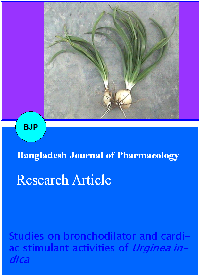Studies on bronchodilator and cardiac stimulant activities of Urginea indica
DOI:
https://doi.org/10.3329/bjp.v8i3.14825Keywords:
Anticholinergic, Bronchodilator, Ca2 antagonist, Cardiac-stimulant, Urginea indicaAbstract
This study was designed to evaluate bronchodilator and cardio-tonic effects of Urginea indica to provide rational for these medicinal uses. U. indica bulb extract was studied on rabbit tracheal and guinea-pig atrial preparations mounted in tissue baths under simulated physiological conditions. U. indica inhibited carbachol (1 µM) and K+ (80 mM)-induced contractions in rabbit trachea, similar to dicyclomine, suggesting the presence of anticholinergic and calcium channel blocking (CCB) mechanisms in U. indica. Anticholinergic and CCB effects of U. indica were respectively confirmed when it shifted the carbachol and Ca2+ concentration-response curves rightwards, similar to dicyclomine. U. indica (0.01-1 mg/mL) increased force of guinea-pig atrial contractions without significantly affecting the rate. These data, indicating that U. indica possesses the bronchodilator activity possibly mediated through a combination of anticholinergic and Ca2+ antagonist mechanisms together with selective positive inotropic effect, provide rational for medicinal applications of U. indica in airways and cardiac disorders.
Downloads
480
520 Read
22
References
Abbas S, Bashir S, Khan A, Mehmood MH, Gilani AH. Gastrointestinal stimulant effect of Urginea indica Kunth. and involvement of muscarinic receptors. Phytother Res. 2012; 26: 704-08.
Ahmed T. Calcium antagonists: Potential for asthma therapy. Choices Respire Manage. 1992; 22: 41-43.
Arshad U, Janbaz KH, Bashir S, Najeeb-ur-Rehman, Mehmood MH, Gilani AH. Ethnopharmacological studies on Chrozophora prostrata in perspective of its folkloric reputation as purgative. Bangladesh J Pharmacol. 2012; 7: 243-48.
Baquar SR. Medicinal and poisonous plants of Pakistan. Karachi, Printas, 1989, p 458.
Barceloux DG. Medical toxicology of natural substances: Foods, fungi, medicinal herbs, plants, and venomous animals. Hoboken, John Wiley & Sons Inc, 2008.
Barnes PJ, Hansel TT. Prospects for new drugs for chronic pulmonary disease. Lancet 2004; 364; 985-96.
Boushey HA. Drugs used in asthma. In; Basic and clinical pharmacology. Katzung BG (ed). 10th ed. New York, McGraw-Hill, 2006, pp 315-32.
Deepak AV, Salimath BP. Antiangiogenic and proapoptotic activity of a novel glycoprotein from Urginea indica is mediated by NF-kappaB and Caspase activated DNase in ascites tumor model. Biochmie. 2006; 88: 297-307.
Downie JW, Twiddy DA, Awad SA. Antimuscrinic and non-competitive antagonist properties of dicyclomine hydro-chloride in isolated human and rabbit bladder muscle. J Pharmacol Exp Ther. 1977: 20; 662-68.
Gilani AH, Bashir S, Khan A. Pharmacological basis for the use of Borago officinalis in gastrointestinal, respiratory and cardiovascular disorders. J Ethnopharmacol. 2007; 114: 393-99.
Gilani AH, Shaheen F, Christopoulos A, Mitchelson F. Interaction of ebeinone, an alkaloid from Fritillaria imperialis, at two muscarinic acetylcholine receptor subtypes. Life Sci. 1997; 60: 535-44.
Kameshwari MNS, Lakshman AB, Paramasivam G. Biosyste-matics studies on medicinal plant Urginea indica Kunth. liliaceae: A review. IJPLS. 2012; 3: 1394-1406.
Kapoor LD. Handbook of Ayurvedic medicinal plants. Boca Raton, CRC Press, 1990, pp 328-29.
Kirtikar KR, Basu BD. Indian medicinal plants. Volume 3. 2nd ed. Dehradun, International Book Distributors, 1987, pp 2518-19.
Mathewson HS. Anti-asthmatic properties of calcium antagonists. Respir Care. 1985; 30: 779-81.
McGrath WR, Lewis RE, Kuhan WL. The dual mode of the antispasmodic effect of dicyclomine hydrochloride. J Pharmacol Exp Ther. 1964; 146: 354-58.
National Research Council. Guide for the care and use of laboratory animals. Washington DC, National Academy Press, 2011.
Prajapati ND, Purohit SS, Sharma AK, Kumar T. A handbook of medicinal plants: A complete source book. New Delhi, Agrobios, 2003, p 529.
Shenoy SR, Kameshwari MN, Swaminathan S, Gupta MN. Major antifungal activity from the bulbs of Indian squill Urginea indica. Biotechnol Prog. 2006; 22: 631-37.
Usmanghani K, Saeed A, Alam MT. Indusyunic Medicine. Karachi, University of Karachi Press, 1997, pp 433-34.
Williamson EM, Okpako DT, Evans FJ. Selection, preparation and pharmacological evaluation of plant material. Chichester, John Wiley & Sons, 1998, pp 15-23.

Published
How to Cite
Issue
Section
License
Authors who publish with this journal agree to the following terms:
- Authors retain copyright and grant the journal right of first publication with the work simultaneously licensed under a Creative Commons Attribution License that allows others to share the work with an acknowledgement of the work's authorship and initial publication in this journal.
- Authors are able to enter into separate, additional contractual arrangements for the non-exclusive distribution of the journal's published version of the work (e.g., post it to an institutional repository or publish it in a book), with an acknowledgement of its initial publication in this journal.
- Authors are permitted and encouraged to post their work online (e.g., in institutional repositories or on their website) prior to and during the submission process, as it can lead to productive exchanges, as well as earlier and greater citation of published work (See The Effect of Open Access).
